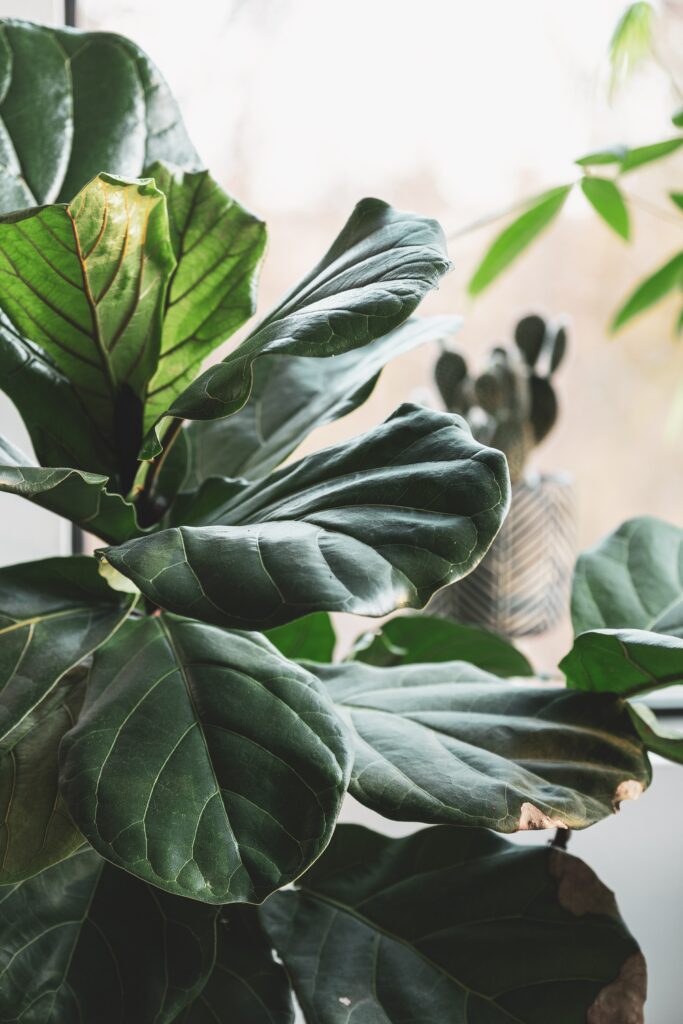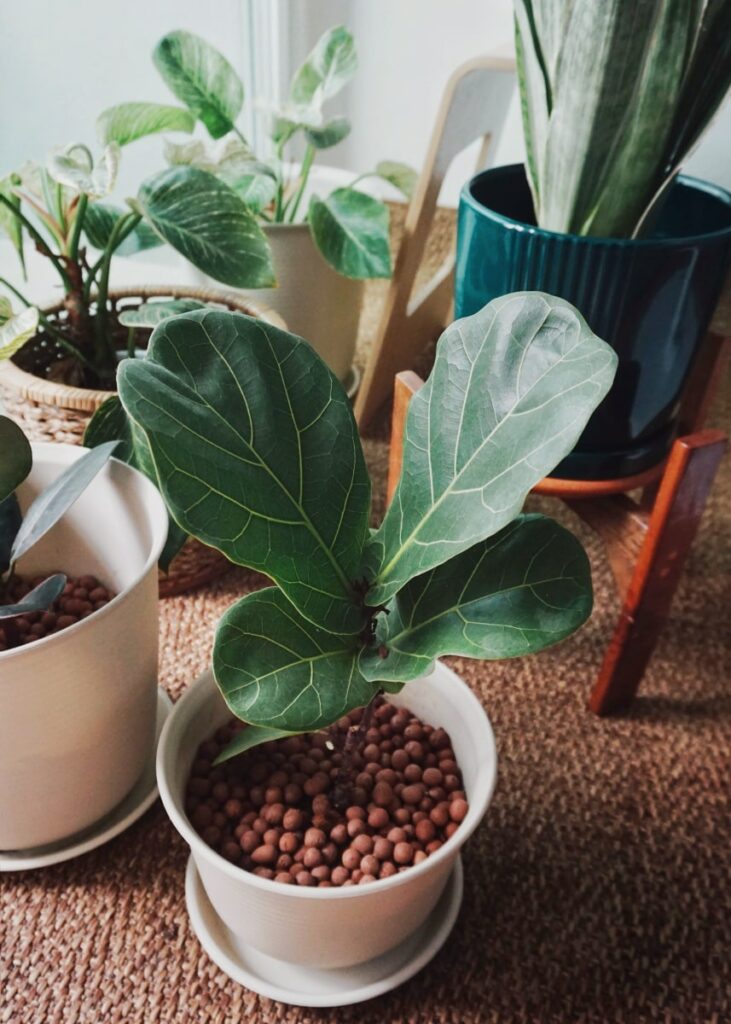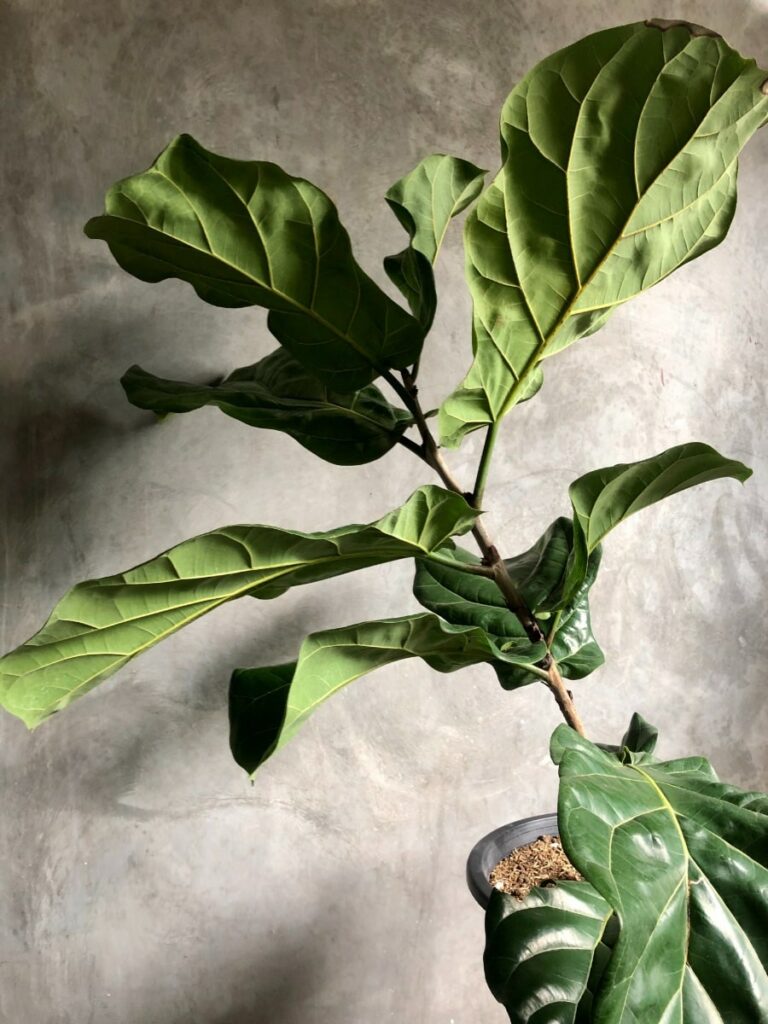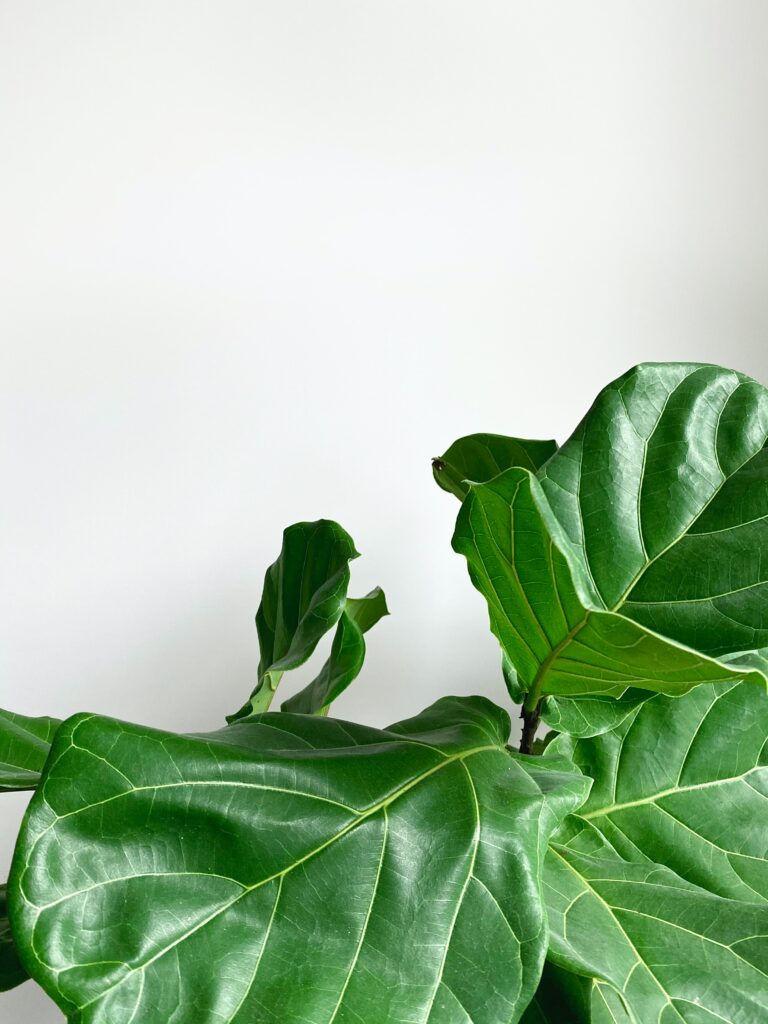The Fiddle Leaf Fig, scientifically known as Ficus lyrata, has become a highly sought-after houseplant in recent years, thanks to its tropical origins in West Africa and its distinctive, violin-shaped leaves that can grow up to 18 inches long and 12 inches wide. This slow-growing plant can reach up to 10 feet tall indoors, making it an ideal addition to any home or office space. Its unique and striking appearance has made it a favorite among plant enthusiasts and interior designers alike, but growing it can be a challenge, particularly when it comes to encouraging it to grow branches. While most Fiddles start as pencil-thin stems, it’s actually easy to make your Fiddle Leaf Fig grow branches and take on a more tree-like structure.
Read on to understand the dynamics of the Fiddle Leaf Fig and how to encourage your plant to grow strong branches at your home.
Understanding Fiddle Leaf Fig Growth Patterns

Before we delve into the intricacies of how to make your Fiddle Leaf Fig grow branches, it’s crucial to comprehend the growth patterns of this beloved houseplant. Fiddle Leaf Figs are indigenous to the tropical rainforests of West Africa and can reach towering heights of up to 50 feet in their natural habitat. However, when cultivated as a houseplant, they typically only attain a height of 6-10 feet.
Fiddle Leaf Figs have a solitary stem that grows vertically, with large, lustrous leaves sprouting from it. In their natural habitat, they grow branches as a means of competing for sunlight and space with other trees. However, when grown indoors, they don’t have the same competition and may not naturally grow branches.
It’s important to note that Fiddle Leaf Figs are slow growing, so don’t anticipate significant growth overnight. It can take several months or even years for a Fiddle Leaf Fig to grow branches.
Furthermore, Fiddle Leaf Figs are highly sensitive to changes in their surroundings, so it’s crucial to provide consistent care and avoid moving them around too much. Any sudden changes in light, temperature, water, or humidity can cause stress and impede growth and could result in discolored or dropped leaves.
By comprehending the growth patterns of your Fiddle Leaf Fig, you can tailor your care routine to encourage branching and overall healthy growth.
Factors Affecting Fiddle Leaf Fig Branching

The branching of your Fiddle Leaf Fig is influenced by a multitude of factors that require careful consideration. Understanding these factors is crucial in creating the perfect conditions for your plant to flourish with healthy and lush branches.
First, the age of your plant plays a significant role in its branching. Younger Fiddle Leaf Figs are less likely to branch out compared to mature plants. Therefore, patience is key as it may take some time before your plant starts to produce branches.
Second, light is a crucial factor in the growth of your Fiddle Leaf Fig. Bright, indirect light is essential for its thriving. Insufficient light can cause the plant to become leggy and spindly, with fewer branches. However, too much direct sunlight can scorch the leaves and stunt the growth of the plant.
Third, watering your Fiddle Leaf Fig is a delicate balance that can affect its branching. Overwatering or underwatering can lead to root rot, which can weaken the plant and inhibit branching. On the other hand, underwatering can cause the leaves to wilt and drop, which can also affect the plant’s overall health.
Fourth, nutrients are essential for the healthy growth and branching of your Fiddle Leaf Fig. Regular fertilization is necessary to promote healthy growth and branching. A lack of nutrients can cause the plant to become weak and spindly, with fewer branches.
Last, pruning is a crucial aspect of encouraging branching in your Fiddle Leaf Fig. Regular pruning can stimulate new growth and encourage the plant to produce more branches. By removing the top of the plant or cutting back the stems, you can create the perfect conditions for your plant to flourish with healthy and lush branches.
By taking into account these factors, you can create the ideal conditions for your Fiddle Leaf Fig to grow healthy and lush branches. With proper care and attention, your plant will thrive and become a beautiful addition to your home.
Pruning and Pinching Techniques for Fiddle Leaf Fig Branching

Pruning your Fiddle Leaf Fig can be a daunting task, but it is an essential technique for promoting branching. By cutting off the top of the stem, you can stimulate the growth of new branches. However, there are several pruning techniques that you can use to encourage branching in your Fiddle Leaf Fig, and we’re going to explore them all!
Pinching the leaf tip to encourage branch growth
One of the easiest ways to encourage branching is to pinch off the top leaf tip of your Fiddle Leaf Fig. This will stimulate the growth of new buds, which will eventually turn into branches. But, if your Fiddle Leaf Fig has grown too tall and has no branches, you can cut back the stem to encourage branching. Use a sharp, clean pair of pruning shears to cut the stem just above a leaf node. This will encourage the growth of new branches from the leaf node.
Dead or damaged leaves can hinder the growth of new branches, so it’s essential to remove them. Additionally, the best time to prune your Fiddle Leaf Fig is in the spring or summer when it is actively growing. This will give it the best chance to recover and produce new growth.
It’s important to remember to always use clean, sharp pruning shears when pruning your Fiddle Leaf Fig. This will prevent the spread of disease and ensure a clean cut. With these pruning techniques, you can encourage branching in your Fiddle Leaf Fig and create a fuller, more attractive plant. So, get pruning and watch your Fiddle Leaf Fig flourish!
Notching Your Fiddle Leaf Stem to Promote Branching
Notching is a technique that involves cutting your tree’s stem to encourage new growth. Whenever you cut a Fiddle Leaf Fig stem, new growth will always appear as two branches. This is also true of you notch a branch: the result will be two smaller branches. Over time, this can help your tree to develop a complex and beautiful shape.
Even better, when you cut your stem, the growth you remove can be propagated into a new plant. Many use these in the same pots as their parents for bushier foliage, or as gifts for friends. We’ll review the two main ways to notch your plant, starting with stem cuttings.
Note: Be extra careful when cutting your plant. Sharp shears should be handled carefully, and you may notice a sticky substance on your cut plant that can irritate skin and eyes. Be incredibly careful about handling your plant, and be sure to keep pets away from recently propagated Fiddles.
Notching via Stem Cutting:
Stem cutting is the easiest way to propagate your Fiddle Leaf Fig. When you cut the stem of your plant, two buds will eventually form at the cut, eventually forming branches. This will encourage your plant to create a lusher canopy of leaves, while providing you with new child plants. Here’s how to take a stem cutting from a healthy Fiddle Leaf Fig:
1. First, select a healthy stem with at least two leaves and a node, which is a small bump on the stem where leaves and branches grow.
2. Cut the stem at a 45-degree angle just below the node.
3. Remove the bottom leaves from the stem, leaving only two or three at the top.
4. Dip the cut end of the stem in rooting hormone powder.
5. Plant the stem in a pot filled with well-draining soil.
6. Water the soil and cover the pot with a plastic bag to create a humid environment.
7. Place the pot in a bright, indirect light and wait for roots to form.
Note: You can also place the cut stem in a vase of water instead of directly into soil. This has about the same chances of success with the advantage of allowing you to see root growth over the weeks they take to develop. Once roots form secondary root segments, it’s safe to carefully pot them up.
Notching via Air Layering:
This technique encourages root growth before you completely cut through your plant. It’s effective, but more advanced:
1. Choose a healthy stem and make a small cut in the bark about 1/3 of the way through the stem.
2. Wrap the cut area with damp sphagnum moss and cover it with plastic wrap.
3. Secure the plastic wrap with tape or a rubber band.
4. Wait for roots to form in the moss.
5. Cut the stem below the moss and plant it in a pot filled with well-draining soil.
6. Water the soil and place the pot in a bright, indirect light.
The perfect time to do either notching technique is spring or summer when the Fiddle is preparing for growth. Still, it’s important to note that both of these methods can take several weeks or even months to produce new growth. So, be patient and keep an eye on your plant’s progress. With a little care and attention, you can encourage your Fiddle Leaf Fig to grow beautiful, healthy branches. Know that these changes take a big impact on your plant and require a lot of energy. Be patient and attentive to its care needs and you should have beautiful branches soon!
Fertilization and Nutrient Management for Fiddle Leaf Fig Branching

Fiddle leaf figs are a finicky plant that require a delicate balance of fertilization and nutrient management to achieve optimal branching. The fertilizer should contain a balanced blend of nitrogen, phosphorus, and potassium, as well as other essential micronutrients.
During the growing season, which typically runs from spring to fall, you should fertilize your fiddle leaf fig every two to four weeks. However, during the winter months, when the plant is in a dormant phase, you can reduce the frequency of fertilization to once every two months. But beware, over-fertilization can lead to nutrient burn, which can damage the roots and leaves of your plant.
When applying fertilizer, be sure to follow the instructions on the label carefully. It is also important to water your plant thoroughly before and after fertilization to prevent the buildup of salts in the soil. This burst of nutrients can help your plant produce healthy and strong branches, which can enhance the overall appearance of your plant.
In addition to fertilization, proper nutrient management is also important for fiddle leaf fig branching. Make sure your plant is getting enough sunlight, as this is essential for photosynthesis and the production of energy for growth. You should also ensure that your plant is getting enough water, but not too much, as overwatering can lead to root rot and other issues.
Finally, consider supplementing your plant’s nutrient intake with organic matter, such as compost or worm castings. These natural fertilizers can help improve soil quality and provide your plant with essential micronutrients that may be lacking in synthetic fertilizers. By following these tips for fertilization and nutrient management, you can help your fiddle leaf fig produce healthy and strong branches, which can enhance the beauty and vitality of your plant.
Common Problems and Solutions for Fiddle Leaf Fig Branching

Fiddle Leaf Figs are a popular houseplant due to their striking appearance, featuring large, glossy leaves and tall, slender trunks. Fear not, as we have compiled a list of common problems and solutions for Fiddle Leaf Fig branching that will help you tackle this issue with ease.
One of the most common problems that can hinder Fiddle Leaf Fig branching is a lack of light. These plants require bright, indirect light to thrive, and if they don’t receive enough light, they may not produce branches. The solution to this problem is simple: move your plant to a brighter location or consider adding a grow light. This will help your plant receive the necessary light it needs to grow branches.
Another issue that can prevent Fiddle Leaf Figs from branching is overwatering. Overwatering can lead to root rot, which can be detrimental to the plant’s growth. To solve this problem, allow the soil to dry out slightly between waterings and make sure your pot has proper drainage. This will help prevent root rot and promote healthy growth.
On the other hand, if your Fiddle Leaf Fig is not getting enough water, it may not have the energy to produce branches.
Fiddle Leaf Figs also require regular fertilization to grow and produce branches. If your plant is lacking nutrients, it may not be able to produce branches. To solve this problem, use a balanced fertilizer every 2-4 weeks during the growing season (spring and summer). This will provide your plant with the necessary nutrients to grow and thrive.
Last, pruning can be a crucial factor in promoting Fiddle Leaf Fig branching. If your plant is not producing branches, it may be because you are not pruning it correctly. To solve this problem, prune your plant regularly to encourage branching. Cut back the top of the plant to promote lateral growth and remove any dead or damaged leaves. This will help your plant grow more branches and become a beautiful, full plant.
By addressing these common problems and following the solutions provided, you can help your Fiddle Leaf Fig grow branches and become a stunning addition to your home.
Conclusion and Final Tips for Fiddle Leaf Fig Branching Success

Growing branches on your Fiddle Leaf Fig can be a truly rewarding experience, but it requires a great deal of patience and dedication. By following the tips outlined in this article, you can encourage your plant to grow new branches and achieve a fuller, more lush appearance.
It is important to remember that providing your Fiddle Leaf Fig with plenty of bright, indirect light is crucial to its success. Overwatering or underwatering can be detrimental to your plant’s growth, so it is important to find the right balance. Additionally, using a high-quality fertilizer can promote healthy growth and encourage branching.
If you find that your Fiddle Leaf Fig is struggling to branch, don’t give up! It may take some time, but with the right care and attention, your plant will eventually reward you with new growth.
Here are some final tips for Fiddle Leaf Fig branching success:
– Provide your plant with plenty of bright, indirect light
– Avoid overwatering or underwatering
– Use a high-quality fertilizer to promote healthy growth
– Consider pruning your plant to encourage branching
– Be patient and persistent in your efforts
With these tips in mind, you’ll be well on your way to growing a beautiful, healthy Fiddle Leaf Fig with plenty of branches. Happy gardening!
Frequently Asked Questions
How often should I water my Fiddle Leaf Fig?
Fiddle Leaf Figs prefer to be kept on the drier side, so it’s important not to overwater them. Water your plant when the top inch of soil feels dry to the touch. This could be anywhere from once a week to once every two weeks, depending on the humidity and temperature in your home.
What kind of fertilizer should I use?
Use a balanced, water-soluble fertilizer with an NPK ratio of 3-1-2. Fertilize your Fiddle Leaf Fig once a month during the growing season (spring and summer) and reduce to every other month during the dormant season (fall and winter).
How much light does my Fiddle Leaf Fig need?
Fiddle Leaf Figs need bright, indirect light to thrive. Place your plant near a window that receives bright, filtered light for most of the day. Avoid placing it in direct sunlight, as this can scorch the leaves.
How can I encourage my Fiddle Leaf Fig to grow branches?
Prune your Fiddle Leaf Fig to encourage branching. Cut back the top of the plant to just above a leaf node (where a leaf attaches to the stem). This will encourage new growth at the node and help your plant develop a fuller, bushier shape.
What should I do if my Fiddle Leaf Fig isn’t growing?
If your Fiddle Leaf Fig isn’t growing, it may not be getting enough light or nutrients. Make sure it’s getting bright, indirect light and fertilize it regularly. You may also want to consider repotting your plant if it’s been in the same pot for a long time.
